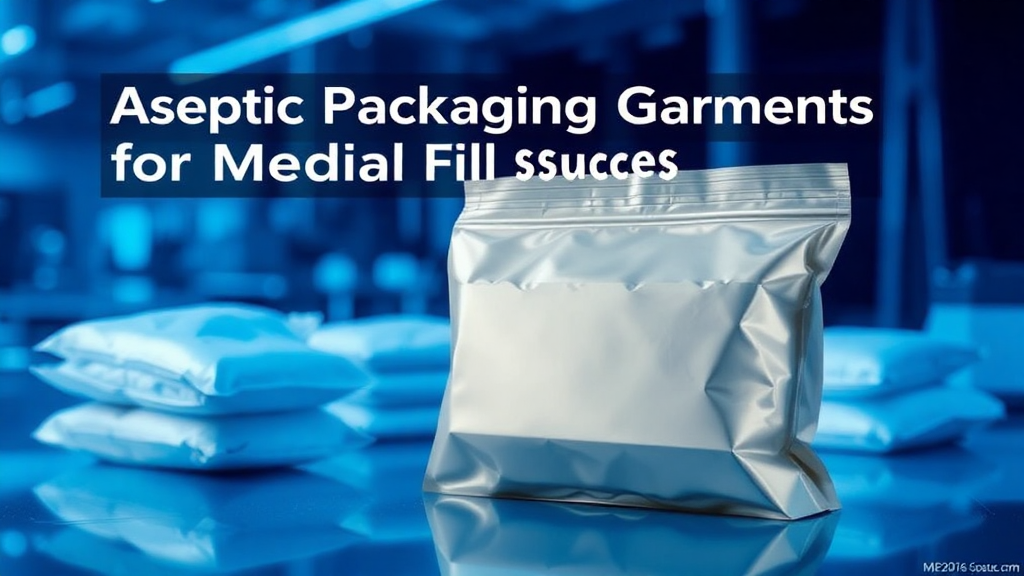Aseptic Packaging Garments for Media Fill Success

In the world of injectable drug manufacturing, maintaining sterility is paramount. Aseptic packaging garments play a crucial role in ensuring the integrity of media fills and ultimately, the safety of pharmaceutical products. This blog post explores how advanced garments address shedding issues, ensuring process validation and compliance in sterile environments.
The Importance of Aseptic Packaging Garments
Sterile fill operators are the frontline defenders against contamination in aseptic environments. The quality of their protective clothing directly impacts the success of media fills and the overall sterility of the manufacturing process. Garment shedding, even at microscopic levels, can introduce foreign particles into the sterile field, potentially compromising product integrity and patient safety.
High-quality aseptic packaging garments serve multiple critical functions:
- Maintaining sterility: They create a barrier between the operator and the sterile environment, preventing the introduction of microorganisms.
- Particle containment: Advanced garments minimize shedding, reducing the risk of particulate contamination.
- Regulatory compliance: Proper garments help manufacturers meet stringent industry standards and regulatory requirements.
- Process validation: Reliable garments contribute to consistent, reproducible media fill results, essential for validating aseptic processes.

Common Challenges with Garment Shedding
Despite best efforts, garment shedding remains a persistent challenge in aseptic environments. Some common issues include:
- Fabric degradation: Over time and with repeated use, garment materials can break down, leading to increased shedding.
- Poor fit: Ill-fitting garments are more likely to generate particles through friction and movement.
- Inadequate cleaning procedures: Improper laundering can leave residues that contribute to shedding.
- Material limitations: Some traditional garment materials are inherently prone to shedding.
- Environmental stress: Factors like humidity and temperature fluctuations can accelerate garment degradation.
These challenges can have significant impacts on media fill integrity and process validation:
- False positives: Shed particles can be mistaken for microbial contamination, leading to unnecessary investigations and production delays.
- Inconsistent results: Varying levels of shedding between garments or operators can produce inconsistent media fill outcomes, complicating validation efforts.
- Increased costs: Failed media fills due to garment shedding result in wasted resources and potential production shutdowns.
- Regulatory scrutiny: Persistent shedding issues can attract unwanted attention from regulatory bodies, potentially jeopardizing compliance status.

Innovative Solutions for Low-Shedding Garments
Advancements in materials science and garment design have led to significant improvements in aseptic packaging apparel. Modern low-shedding garments incorporate several innovative features:
- Advanced fabrics: Synthetic materials like polyester and nylon blends offer superior particle retention compared to traditional cotton.
- Seamless construction: Ultrasonic welding and other advanced joining techniques minimize weak points where shedding typically occurs.
- Encapsulated fibers: Some garments feature fibers that are sealed within a polymer matrix, dramatically reducing shedding potential.
- Electrostatic properties: Certain materials are designed to repel particles, further minimizing contamination risks.
- Ergonomic design: Garments tailored for comfort and ease of movement reduce friction and associated shedding.
These innovations result in garments that consistently achieve ≤0.5 CFU/cm² microbial cleanliness, meeting the most stringent industry standards for sterile environments.

Best Practices for Garment Validation
Implementing a robust garment validation program is essential for maintaining the integrity of aseptic processes. Consider the following best practices:
- Establish clear acceptance criteria: Define specific, measurable standards for garment cleanliness and shedding levels.
- Implement regular testing: Conduct routine particle and microbial testing on garments to ensure ongoing compliance.
- Document thoroughly: Maintain detailed records of garment testing, cleaning procedures, and usage history.
- Train operators: Provide comprehensive training on proper garment donning, doffing, and handling procedures.
- Perform periodic audits: Regularly review garment management processes to identify areas for improvement.
- Stay informed: Keep abreast of the latest industry standards and regulatory guidance related to aseptic garments.
For more detailed information on media fill best practices, including garment considerations, visit our media fill resources page.
Case Study: Achieving Media Fill Success with Low-Shedding Garments
A leading pharmaceutical company was struggling with persistent media fill failures, jeopardizing their ability to validate aseptic processes. After investigation, they identified garment shedding as a significant contributing factor.
The company implemented a comprehensive garment upgrade program, focusing on low-shedding aseptic packaging apparel. Key steps included:
- Sourcing advanced, low-shedding garments with proven performance in sterile environments.
- Implementing rigorous garment testing and validation protocols.
- Retraining all sterile fill operators on proper garment handling and aseptic techniques.
- Upgrading garment management systems, including cleaning and storage procedures.
The results were dramatic:
- Media fill failures reduced by 90% within six months of implementation.
- Particulate contamination levels consistently met the ≤0.5 CFU/cm² target.
- Regulatory inspections noted significant improvements in aseptic process control.
- The company achieved smoother, more efficient process validation cycles.
This case demonstrates the profound impact that high-quality, low-shedding garments can have on media fill success and overall aseptic process validation.
وچان وچان سوال ڪرڻ
What causes garment shedding during media fills?
Garment shedding can be caused by fabric degradation, poor fit, inadequate cleaning procedures, suboptimal material choices, and environmental stress. Regular movement and friction during operations can exacerbate these issues.
How can I validate aseptic packaging garments?
Garment validation typically involves particle testing, microbial testing, and visual inspection. Establish clear acceptance criteria, perform regular testing, and maintain thorough documentation of all validation activities.
What materials are best for low-shedding garments?
Advanced synthetic materials like polyester and nylon blends, especially those with encapsulated fibers or electrostatic properties, generally offer superior shedding resistance compared to traditional cotton garments.
Are there industry standards for aseptic garment testing?
Yes, several standards provide guidance on aseptic garment testing, including ISO 14644 (Cleanrooms and associated controlled environments) and IEST-RP-CC003 (Garment System Considerations for Cleanrooms and Other Controlled Environments).
In conclusion, high-quality, low-shedding aseptic packaging garments are essential for media fill success and overall process validation in injectable drug manufacturing. By investing in advanced garments and implementing robust validation practices, manufacturers can significantly enhance their sterile production capabilities and ensure regulatory compliance.
Ready to elevate your aseptic processes with validated, low-shedding garments? Request Validation Support from our team of experts today.








